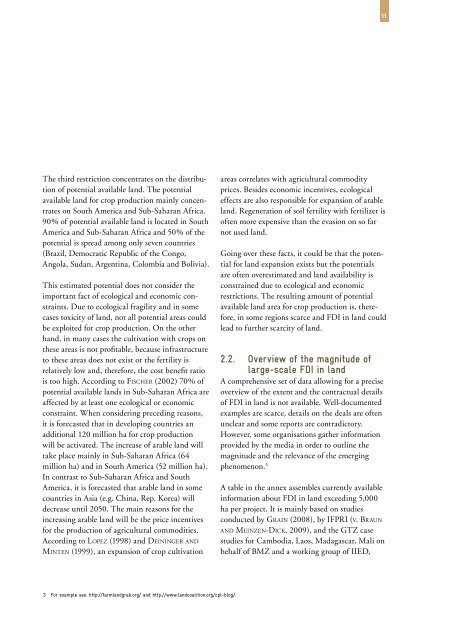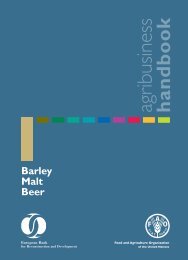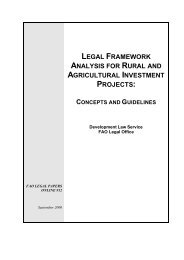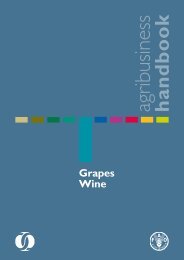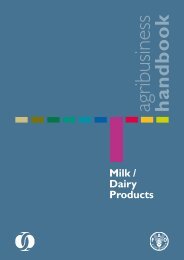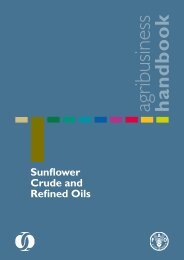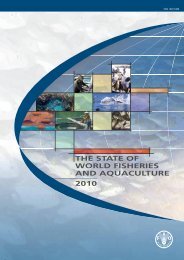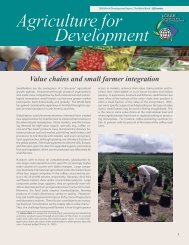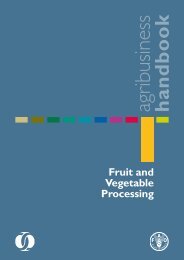Foreign Direct Investment (FDI) in Land in developing countries
Foreign Direct Investment (FDI) in Land in developing countries
Foreign Direct Investment (FDI) in Land in developing countries
- No tags were found...
Create successful ePaper yourself
Turn your PDF publications into a flip-book with our unique Google optimized e-Paper software.
11The third restriction concentrates on the distributionof potential available land. The potentialavailable land for crop production ma<strong>in</strong>ly concentrateson South America and Sub-Saharan Africa.90% of potential available land is located <strong>in</strong> SouthAmerica and Sub-Saharan Africa and 50% of thepotential is spread among only seven <strong>countries</strong>(Brazil, Democratic Republic of the Congo,Angola, Sudan, Argent<strong>in</strong>a, Colombia and Bolivia).This estimated potential does not consider theimportant fact of ecological and economic constra<strong>in</strong>ts.Due to ecological fragility and <strong>in</strong> somecases toxicity of land, not all potential areas couldbe exploited for crop production. On the otherhand, <strong>in</strong> many cases the cultivation with crops onthese areas is not profitable, because <strong>in</strong>frastructureto these areas does not exist or the fertility isrelatively low and, therefore, the cost benefit ratiois too high. Accord<strong>in</strong>g to Fischer (2002) 70% ofpotential available lands <strong>in</strong> Sub-Saharan Africa areaffected by at least one ecological or economicconstra<strong>in</strong>t. When consider<strong>in</strong>g preced<strong>in</strong>g reasons,it is forecasted that <strong>in</strong> develop<strong>in</strong>g <strong>countries</strong> anadditional 120 million ha for crop productionwill be activated. The <strong>in</strong>crease of arable land willtake place ma<strong>in</strong>ly <strong>in</strong> Sub-Saharan Africa (64million ha) and <strong>in</strong> South America (52 million ha).In contrast to Sub-Saharan Africa and SouthAmerica, it is forecasted that arable land <strong>in</strong> some<strong>countries</strong> <strong>in</strong> Asia (e.g. Ch<strong>in</strong>a, Rep. Korea) willdecrease until 2050. The ma<strong>in</strong> reasons for the<strong>in</strong>creas<strong>in</strong>g arable land will be the price <strong>in</strong>centivesfor the production of agricultural commodities.Accord<strong>in</strong>g to Lopez (1998) and De<strong>in</strong><strong>in</strong>ger andM<strong>in</strong>ten (1999), an expansion of crop cultivationareas correlates with agricultural commodityprices. Besides economic <strong>in</strong>centives, ecologicaleffects are also responsible for expansion of arableland. Regeneration of soil fertility with fertilizer isoften more expensive than the evasion on so farnot used land.Go<strong>in</strong>g over these facts, it could be that the potentialfor land expansion exists but the potentialsare often overestimated and land availability isconstra<strong>in</strong>ed due to ecological and economicrestrictions. The result<strong>in</strong>g amount of potentialavailable land area for crop production is, therefore,<strong>in</strong> some regions scarce and <strong>FDI</strong> <strong>in</strong> land couldlead to further scarcity of land.2.2. Overview of the magnitude oflarge-scale <strong>FDI</strong> <strong>in</strong> landA comprehensive set of data allow<strong>in</strong>g for a preciseoverview of the extent and the contractual detailsof <strong>FDI</strong> <strong>in</strong> land is not available. Well-documentedexamples are scarce, details on the deals are oftenunclear and some reports are contradictory.However, some organisations gather <strong>in</strong>formationprovided by the media <strong>in</strong> order to outl<strong>in</strong>e themagnitude and the relevance of the emerg<strong>in</strong>gphenomenon. 3A table <strong>in</strong> the annex assembles currently available<strong>in</strong>formation about <strong>FDI</strong> <strong>in</strong> land exceed<strong>in</strong>g 5,000ha per project. It is ma<strong>in</strong>ly based on studiesconducted by Gra<strong>in</strong> (2008), by IFPRI (v. Braunand Me<strong>in</strong>zen-Dick, 2009), and the GTZ casestudies for Cambodia, Laos, Madagascar, Mali onbehalf of BMZ and a work<strong>in</strong>g group of IIED,3 For example see: http://farmlandgrab.org/ and http://www.landcoalition.org/cpl-blog/.


